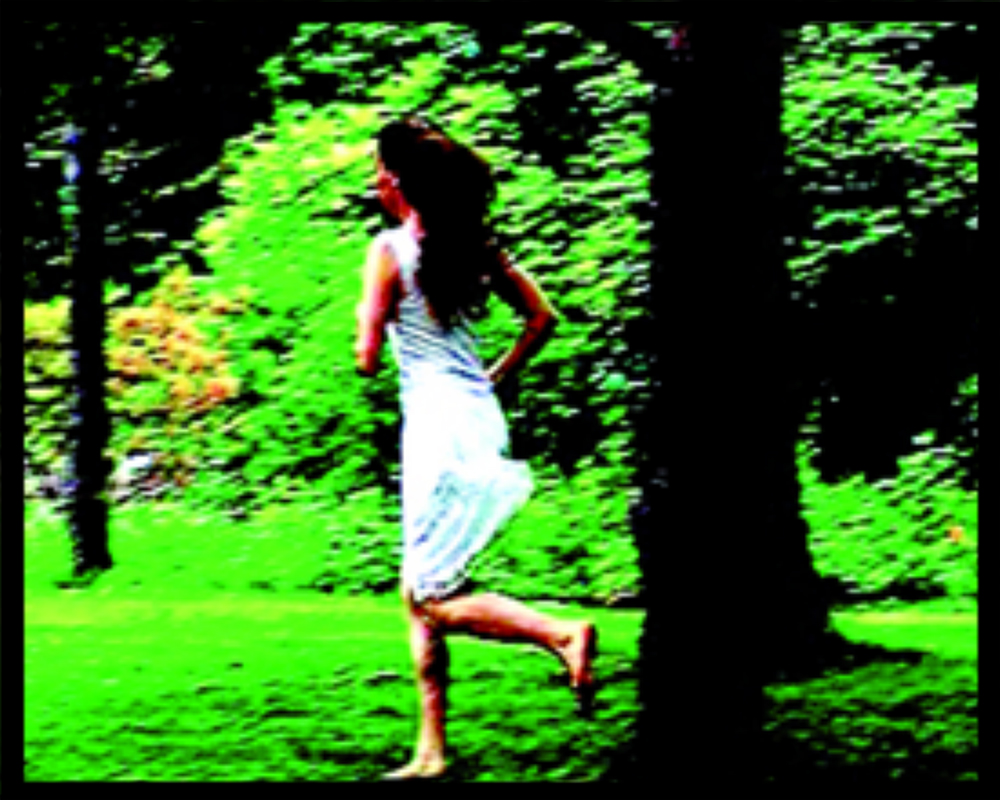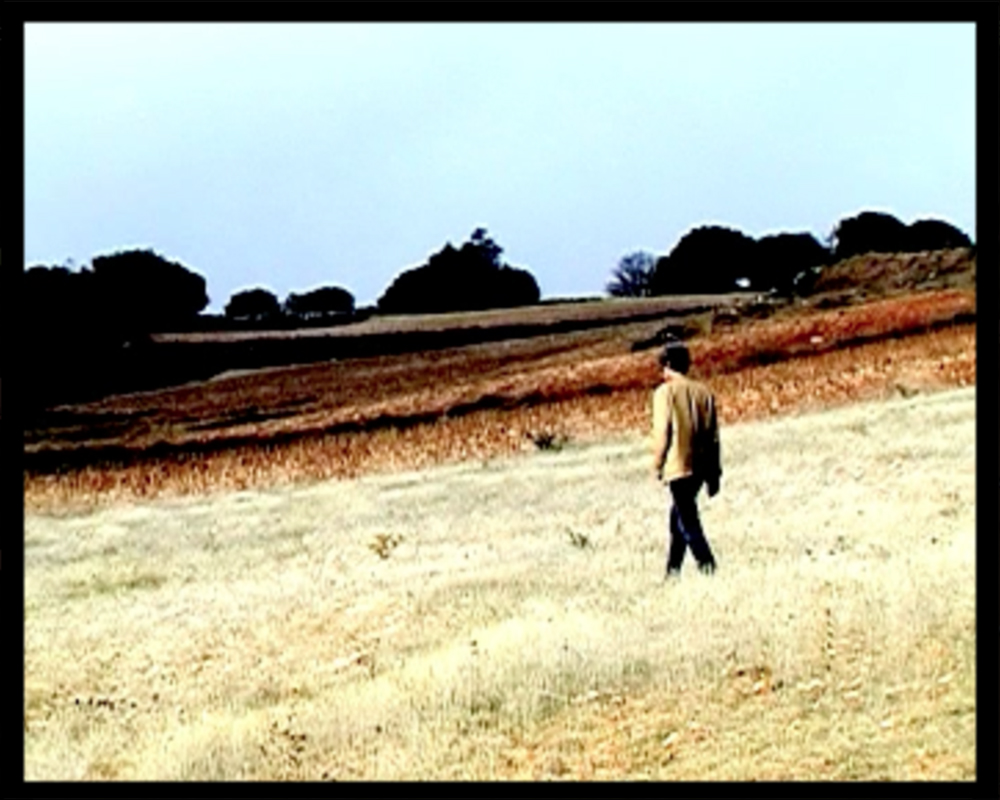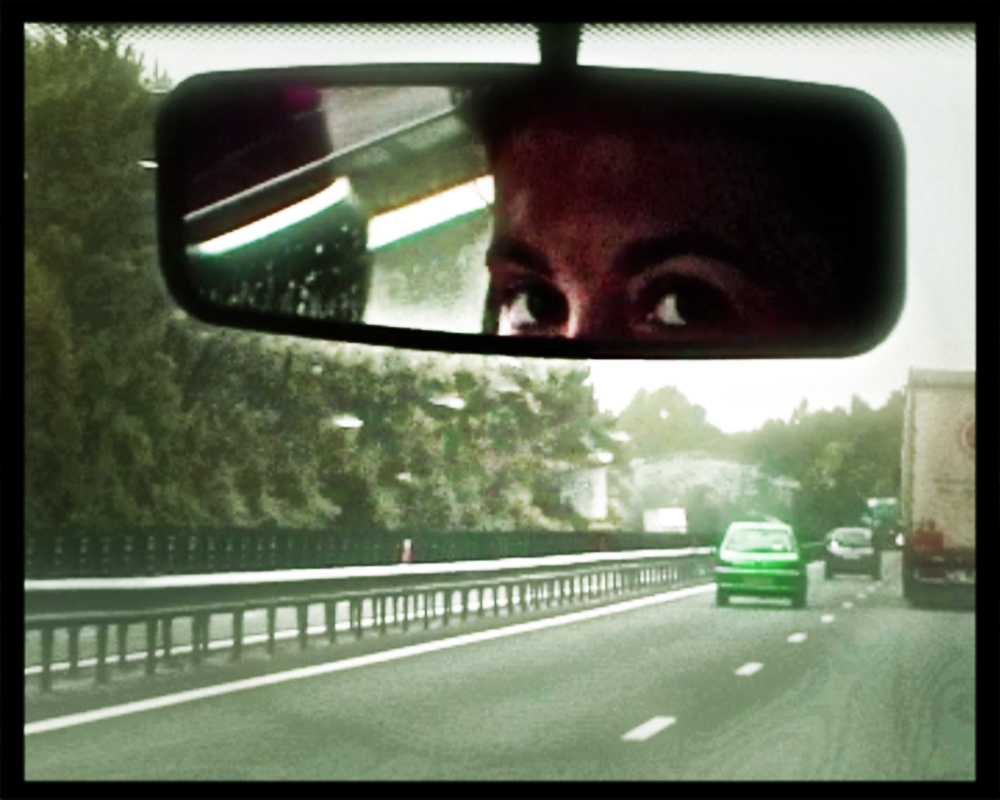ROMANCERO
Romancero streams video extracts from twenty years of the artist’s archives into a fluid, moving edit. Distant or familiar landscapes, known or unknown people, urban scenes and moments of private life, conversations, thoughts, phrases, quotes come up and mingle into a new order, a new interpretation, a new temporality – as if they were theatre actors performing a play again. Fragments of life come into motion, erupting freely to recompose a new version, made of intensity and condensed visions. The video sequences are like incandescent embers; nuggets igniting back into flames and into life when they are seen. Their sequencing follows unconscious associations rather than those related to rational narration.
Romancero is part of a process of total work, Gesamtkunstwerk, an attempt to assemble life and work, referring to Susan Sontag’s maxim: “Each one of us should show his or her life as a plan of sequences and make a film of it. This is how memory functions.” The soundtrack, by the musician Push, accompanies the visual flux, linking the sequences to each other while opening the space with echoes and repetitions.
-

Romancero 1, 2011, 5'57" (excerpt)
Romancero streams video extracts from twenty years of the artist’s archives into a fluid, moving edit. Distant or familiar landscapes, known or unknown people, urban scenes and moments of private life, conversations, thoughts, phrases, quotes come up and mingle into a new order, a new interpretation, a new temporality – as if they were theatre actors performing a play again. Fragments of life come into motion, erupting freely to recompose a new version, made of intensity and condensed visions. The video sequences are like incandescent embers; nuggets igniting back into flames and into life when they are seen. Their sequencing follows unconscious associations rather than those related to rational narration.
Romancero is part of a process of total work, Gesamtkunstwerk, an attempt to assemble life and work, referring to Susan Sontag’s maxim: “Each one of us should show his or her life as a plan of sequences and make a film of it. This is how memory functions.” The soundtrack, by the musician Push, accompanies the visual flux, linking the sequences to each other while opening the space with echoes and repetitions.
-

Romancero 2, 2011, 7'13'' (excerpt)
Romancero streams video extracts from twenty years of the artist’s archives into a fluid, moving edit. Distant or familiar landscapes, known or unknown people, urban scenes and moments of private life, conversations, thoughts, phrases, quotes come up and mingle into a new order, a new interpretation, a new temporality – as if they were theatre actors performing a play again. Fragments of life come into motion, erupting freely to recompose a new version, made of intensity and condensed visions. The video sequences are like incandescent embers; nuggets igniting back into flames and into life when they are seen. Their sequencing follows unconscious associations rather than those related to rational narration.
Romancero is part of a process of total work, Gesamtkunstwerk, an attempt to assemble life and work, referring to Susan Sontag’s maxim: “Each one of us should show his or her life as a plan of sequences and make a film of it. This is how memory functions.” The soundtrack, by the musician Push, accompanies the visual flux, linking the sequences to each other while opening the space with echoes and repetitions.
-

Romancero 3, 2011, 7'15'' (excerpt)
Romancero streams video extracts from twenty years of the artist’s archives into a fluid, moving edit. Distant or familiar landscapes, known or unknown people, urban scenes and moments of private life, conversations, thoughts, phrases, quotes come up and mingle into a new order, a new interpretation, a new temporality – as if they were theatre actors performing a play again. Fragments of life come into motion, erupting freely to recompose a new version, made of intensity and condensed visions. The video sequences are like incandescent embers; nuggets igniting back into flames and into life when they are seen. Their sequencing follows unconscious associations rather than those related to rational narration.
Romancero is part of a process of total work, Gesamtkunstwerk, an attempt to assemble life and work, referring to Susan Sontag’s maxim: “Each one of us should show his or her life as a plan of sequences and make a film of it. This is how memory functions.” The soundtrack, by the musician Push, accompanies the visual flux, linking the sequences to each other while opening the space with echoes and repetitions.
Romancero streams video extracts from twenty years of the artist’s archives into a fluid, moving edit. Distant or familiar landscapes, known or unknown people, urban scenes and moments of private life, conversations, thoughts, phrases, quotes come up and mingle into a new order, a new interpretation, a new temporality – as if they were theatre actors performing a play again. Fragments of life come into motion, erupting freely to recompose a new version, made of intensity and condensed visions. The video sequences are like incandescent embers; nuggets igniting back into flames and into life when they are seen. Their sequencing follows unconscious associations rather than those related to rational narration.
Romancero is part of a process of total work, Gesamtkunstwerk, an attempt to assemble life and work, referring to Susan Sontag’s maxim: “Each one of us should show his or her life as a plan of sequences and make a film of it. This is how memory functions.” The soundtrack, by the musician Push, accompanies the visual flux, linking the sequences to each other while opening the space with echoes and repetitions.
Romancero is part of a process of total work, Gesamtkunstwerk, an attempt to assemble life and work, referring to Susan Sontag’s maxim: “Each one of us should show his or her life as a plan of sequences and make a film of it. This is how memory functions.” The soundtrack, by the musician Push, accompanies the visual flux, linking the sequences to each other while opening the space with echoes and repetitions.

Romancero 1, 2011, 5'57" (excerpt)
Romancero streams video extracts from twenty years of the artist’s archives into a fluid, moving edit. Distant or familiar landscapes, known or unknown people, urban scenes and moments of private life, conversations, thoughts, phrases, quotes come up and mingle into a new order, a new interpretation, a new temporality – as if they were theatre actors performing a play again. Fragments of life come into motion, erupting freely to recompose a new version, made of intensity and condensed visions. The video sequences are like incandescent embers; nuggets igniting back into flames and into life when they are seen. Their sequencing follows unconscious associations rather than those related to rational narration.
Romancero is part of a process of total work, Gesamtkunstwerk, an attempt to assemble life and work, referring to Susan Sontag’s maxim: “Each one of us should show his or her life as a plan of sequences and make a film of it. This is how memory functions.” The soundtrack, by the musician Push, accompanies the visual flux, linking the sequences to each other while opening the space with echoes and repetitions.
Romancero is part of a process of total work, Gesamtkunstwerk, an attempt to assemble life and work, referring to Susan Sontag’s maxim: “Each one of us should show his or her life as a plan of sequences and make a film of it. This is how memory functions.” The soundtrack, by the musician Push, accompanies the visual flux, linking the sequences to each other while opening the space with echoes and repetitions.

Romancero 2, 2011, 7'13'' (excerpt)
Romancero streams video extracts from twenty years of the artist’s archives into a fluid, moving edit. Distant or familiar landscapes, known or unknown people, urban scenes and moments of private life, conversations, thoughts, phrases, quotes come up and mingle into a new order, a new interpretation, a new temporality – as if they were theatre actors performing a play again. Fragments of life come into motion, erupting freely to recompose a new version, made of intensity and condensed visions. The video sequences are like incandescent embers; nuggets igniting back into flames and into life when they are seen. Their sequencing follows unconscious associations rather than those related to rational narration.
Romancero is part of a process of total work, Gesamtkunstwerk, an attempt to assemble life and work, referring to Susan Sontag’s maxim: “Each one of us should show his or her life as a plan of sequences and make a film of it. This is how memory functions.” The soundtrack, by the musician Push, accompanies the visual flux, linking the sequences to each other while opening the space with echoes and repetitions.
Romancero is part of a process of total work, Gesamtkunstwerk, an attempt to assemble life and work, referring to Susan Sontag’s maxim: “Each one of us should show his or her life as a plan of sequences and make a film of it. This is how memory functions.” The soundtrack, by the musician Push, accompanies the visual flux, linking the sequences to each other while opening the space with echoes and repetitions.

Romancero 3, 2011, 7'15'' (excerpt)
Romancero streams video extracts from twenty years of the artist’s archives into a fluid, moving edit. Distant or familiar landscapes, known or unknown people, urban scenes and moments of private life, conversations, thoughts, phrases, quotes come up and mingle into a new order, a new interpretation, a new temporality – as if they were theatre actors performing a play again. Fragments of life come into motion, erupting freely to recompose a new version, made of intensity and condensed visions. The video sequences are like incandescent embers; nuggets igniting back into flames and into life when they are seen. Their sequencing follows unconscious associations rather than those related to rational narration.
Romancero is part of a process of total work, Gesamtkunstwerk, an attempt to assemble life and work, referring to Susan Sontag’s maxim: “Each one of us should show his or her life as a plan of sequences and make a film of it. This is how memory functions.” The soundtrack, by the musician Push, accompanies the visual flux, linking the sequences to each other while opening the space with echoes and repetitions.
Romancero is part of a process of total work, Gesamtkunstwerk, an attempt to assemble life and work, referring to Susan Sontag’s maxim: “Each one of us should show his or her life as a plan of sequences and make a film of it. This is how memory functions.” The soundtrack, by the musician Push, accompanies the visual flux, linking the sequences to each other while opening the space with echoes and repetitions.